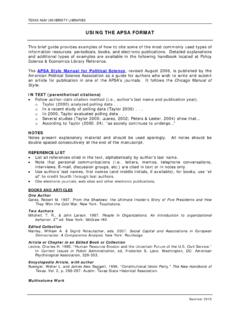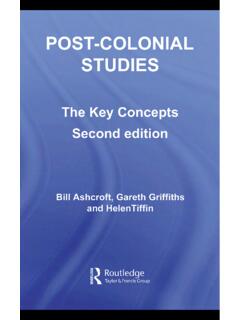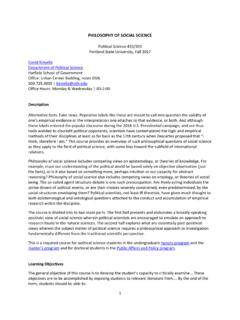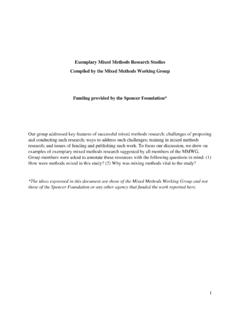Transcription of One-Dimensional Man
1 One-Dimensional Man "In One-Dimensional Man Herbert Marcuse has moved on to what is the central problem of our civilization-how to reconcile orginality and spontaneity and all the creative aspects of our human nature with a prevailing drive to rationality that tends to reduce all varieties of temperament and desire to one universal system of thought and behavior. He does not claim to solve this problem, but by presenting the alternatives in clear and critical terms, he makes the choice inevitable to every socially responsible individual. That is to say, he makes us realize that the choice is now between the life and the death of our civilization." Herbert Read "This is a provocative book of fundamental significance." Transaction "One of the most radical and forceful thinkers of this time." The Nation "The foremost literary symbol of the New Left." The new york Times Herbert Marcuse One-Dimensional Man Studies in the ideology of advanced industrial society With an introduction by Douglas Kellner London and new york First published the United Kingdom 1964 by routledge & Kegan Paul Second edition published 1991 Reprinted 1994, 1999, 2002 First published in routledge Classics 2002 by routledge 2 Park Square, Milton Park, Abingdon, Oxon OX14 4RN 270 Madison Avenue, new york , NY 10016 Reprinted 2006, 2007 routledge is an imprint of the Taylor ( Francis Group, an informa business 1964 Herbert Marcuse Introduction to second edition 1991 Beacon Press Typeset in joanna by RefineCatch Limited, Bungay, Suffolk Printed and bound in Great Britain by Biddies Ltd, King's Lynn, Norfolk All rights reserved.)
2 No part of this book may be reprinted or reproduced or utilised in any form or by any electronic, mechanical,or other means, now known or hereafter invented, including photocopying and recording, or in any information storage or retrieval system, without permission in writing from the publishers. British Library Cataloguing in Publication Data A catalogue record for this book is available from the British Library Library of Congress Cataloging in Publication Data A catalog record for this book has been requested ISBN 978-o-415-28976-4 (hbk) ISBN 978-o-415-28977-1 (pbk) For lnge CONTENTS ACKNOWLEDGMENTS ix INTRODUCTION TO THE SECOND EDITION by Douglas Kellner xi INTRODUCTION TO THE FIRST EDITION The Para lysis of Criticism: Society Without Opposition xxxix PART I One-Dimensional Society The New Forms of Control 3 2 The Closing of the Political Universe 21 3 The Conquest of the Unhappy Consciousness: Repressive Desublimation 59 4 The Closing ofthe Universe of Discourse 87 PART II One-Dimensional Thought 5 Negative Thinking: the Defeated Logic of Protest 127 Viii CONTENTS 6 From Negative to Positive Thinking: Technological Rationality and the Logic of Domination 7 The Triumph of Positive Thinking.
3 One-Dimensional Philosophy PART Ill The Chance of the Alternatives 147 174 8 The Historical Commitment of Philosophy 207 9 The Catastrophe of Liberation 229 10 Conclusion 251 INDEX 263 ACKNOWLEDGMENTS My wife is at least partly responsible for the opinions expressed in this book. I am infinitely grateful to her. My friend Barrington Moore, Jr., has helped me greatly by his critical comments; in discussions over a number of years, he has forced me to clarify my ideas. Robert S. Cohen, Arno ]. Mayer, Hans Meyerhoff, and David Ober read the manuscript at various stages and offered valuable suggestions. The American Council of Learned Societies, the Louis M. Rabinowitz Foundation, the Rockefeller Foundation, and the Social Science Research Council have extended to me grants which greatly facilitated the completion of these studies. INTRODUCTION TO THE SECOND EDITION by Douglas Kellner Herbert Marcuse's One-Dimensional Man was one of the most important books of the First published in 1964, it was immediately recognized as a significant critical diagnosis of the present age and was soon taken up by the emergent New Left as a damning indictment of contemporary Western societies, capit-alist and communist.
4 Conceived and written in the 1950s and early 1960s, the book reflects the stifling conformity of the era and provides a powerful critique of new modes of domination and social control. Yet it also expresses the hopes of a radical philosopher that human freedom and happiness could be greatly expanded beyond the One-Dimensional thought and behavior prevalent in the established society. Holding onto the vision of liberation articulated in his earlier book Eros and Civilization, 2 1 For a fuller discussion of the themes, contributions, and influence of One-Dimensional Man, see Chapters 7-10 of my book Herbert Marcuse and the Crisis of Marxism (London and Berkeley: MacMillan Press and University of California Press, 1984). 2 Herbert Marcuse, Eros and Civilization (Boston: Beacon Press, 19 55). Xii INTRODUCTION TO THE SECOND EDITION Marcuse, in his critique of existing forms of domination and oppression, urges that what is be constantly compared with what could be: a freer and happier mode of human existence.
5 On one hand, One-Dimensional Man is an important work of critical social theory that continues to be relevant today as the forces of domination that Marcuse dissected have become even stronger and more prevalent in the years since he wrote the book. In a prospectus describing his work, Marcuse writes: "This book deals with certain basic tendencies in contemporary industrial society which seem to indicate a new phase of civil-ization. These tendencies have engendered a mode of thought and behavior which undermines the very foundations of the traditional culture. The chief characteristic of this new mode of thought and behavior is the repression of all values, aspirations, and ideas which cannot be defined in terms of the operations and attitudes validated by the prevailing forms of rationality. The consequence is the weakening and even the disappearance of all genuinely radical critique, the integration of all opposition in the established system."3 The book contains a theory of "advanced industrial society" that describes how changes in production, consumption, cul-ture, and thought have produced an advanced state of conform-ity in which the production of needs and aspirations by the prevailing societal apparatus integrates individuals into the estab-lished societies.
6 Marcuse describes what has become known as the "technological society," in which technology restructures labor and leisure, influencing life from the organization of labor to modes of thought. He also describes the mechanisms through which consumer capitalism integrates individuals into its world of thought and behavior. Rather than seeing these developments as beneficial to the individual, Marcuse sees them as a threat to 3 Herbert Marcuse, prospectus for One-Dimensional Man, Beacon Press archives, no date. INTRODUCTION TO THE SECOND EDITION xjjj human freedom and individuality in a totally administered society. Justifying these claims requires Marcuse to develop a critical, philosophical perspective from which he can criticize existing forms of thought, behavior, and social organization. Thus, One-Dimensional Man is also Marcuse's major philosophical work, articulating his Hegelian-Marxian concept of philosophy and critique of dominant philosophical and intellectual currents: positivism, analytic philosophy, technological rationality, and a variety of modes of conformist thinking.
7 In this text, he both explicates his conception of dialectical philosophy and produces analyses of society and culture which exemplify his dialectical categories and method. Consequently, One-Dimensional Man pres-ents a model both of Marcuse' s critical social theory and of his critical philosophy inspired by his philosophical studies and his work with the Frankfurt THE FRANKFURT SCHOOL AND One-Dimensional MAN During the 1920s and early 1930s Marcuse studied with Martin Heidegger in Freiburg, Germany and intensely appropriated the works of Hegel, Marx, phenomenology, existentialism, German idealism, and the classics of the Western philosophical tradition. While he later broke with Heidegger after the rise of National Socialism in Germany and Heidegger's affiliation with the Nazi party, he was influenced by Heidegger's critique of Western philosophy and his attempts to develop a new philosophy. He followed Heidegger and existentialism in seeking to deal with the concrete problems of the existing individual and was 4 On the Frankfurt School, see Martin Jay, The Dialectical Imagination (Boston: Litde, Brown and Company, 19 7 3) and Douglas Kellner, Critical Theory.
8 Marxism, and Modernity (Cambridge and Baltimore: Polity Press and Johns Hopkins University Press, 1989). XiV INTRODUCTION TO THE SECOND EDITION impressed with the phenomenological method of Husserl and Heidegger which attempted to break with abstract philosophical theorizing and to conceptualize "the things themselves" as they appeared to consciousness. In his early works, Marcuse himself attempted to synthesize Heidegger' s phenomenological existentialism with Marxism, and in One-Dimensional Man one recognizes Husserlian and Heideggerian motifs in Marcuse's critiques of scientific civiliza-tion and modes of thought. In particular, Marcuse develops a conception of a technological world, similar in some respects to that developed by Heidegger, and, like Husserl and Heidegger, sees technological rationality colonizing everyday life, robbing individuals of freedom and individuality by imposing techno-logical imperatives, rules, and structures upon their thought and behavior.
9 Marcuse thought that dialectical philosophy could promote critical thinking. One-Dimensional Man is perhaps Marcuse's most sustained attempt to present and develop the categories of the dialectical philosophy developed by Hegel and Marx. For Mar-cuse, dialectical thinking involved the ability to abstract one's perception and thought from existing forms in order to form more general concepts. This conception helps explain the dif-ficulty of One-Dimensional Man and the demands that it imposes upon its reader. For Marcuse abstracts from the complexity and multiplicity of the existing society its fundamental tendencies and constituents, as well as those categories which constitute for him the forms of critical thinking. This demands that the reader also abstract from existing ways of looking at society and modes of thinking and attempt to perceive and think in a new way. Uncritical thinking derives its beliefs, norms, and values from existing thought and social practices, while critical thought seeks alternative modes of thought and behavior from which it creates a standpoint of critique.
10 Such a critical standpoint requires developing what Marcuse calls "negative thinking," INTRODUCTION TO THE SECOND EDITION XV which "negates" existing forms of thought and reality from the perspective of higher possibilities. This practice presupposes the ability to make a distinction between existence and essence, fact and potentiality, and appearance and reality. Mere existence would be negated in favor of realizing higher potentialities while norms discovered by reason would be used to criticize and overcome lower forms of thought and social organization. Thus grasping potentialities for freedom and happiness would make possible the negation of conditions that inhibited individuals' full development and realization. In other words, perceiving the possibility of self-determination and constructing one's own needs and values could enable individuals to break with the existing world of thought and behavior. Philosophy was thus to supply the norms for social criticism and the ideal of liberation which would guide social change and individual self-transformation.







